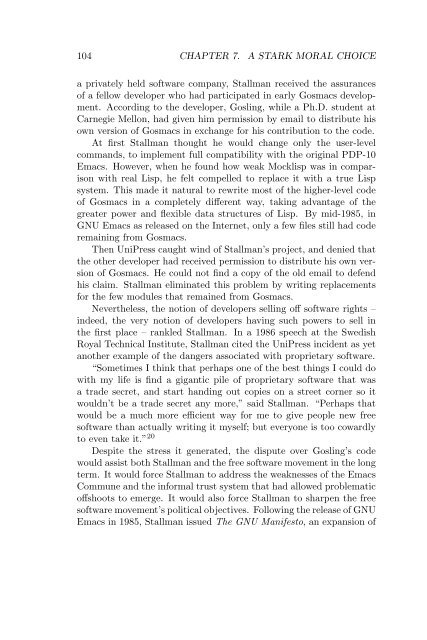Create successful ePaper yourself
Turn your PDF publications into a flip-book with our unique Google optimized e-Paper software.
104 CHAPTER 7. A STARK MORAL CHOICE<br />
a privately held software company, Stallman received the assurances<br />
of a fellow developer who had participated in early Gosmacs development.<br />
According to the developer, Gosling, while a Ph.D. student at<br />
Carnegie Mellon, had given him permission by email to distribute his<br />
own version of Gosmacs in exchange for his contribution to the code.<br />
At first Stallman thought he would change only the user-level<br />
commands, to implement full compatibility with the original PDP-10<br />
Emacs. However, when he found how weak Mocklisp was in comparison<br />
with real Lisp, he felt compelled to replace it with a true Lisp<br />
system. This made it natural to rewrite most of the higher-level code<br />
of Gosmacs in a completely different way, taking advantage of the<br />
greater power and flexible data structures of Lisp. By mid-1985, in<br />
GNU Emacs as released on the Internet, only a few files still had code<br />
remaining from Gosmacs.<br />
Then UniPress caught wind of Stallman’s project, and denied that<br />
the other developer had received permission to distribute his own version<br />
of Gosmacs. He could not find a copy of the old email to defend<br />
his claim. Stallman eliminated this problem by writing replacements<br />
for the few modules that remained from Gosmacs.<br />
Nevertheless, the notion of developers selling off software rights –<br />
indeed, the very notion of developers having such powers to sell in<br />
the first place – rankled Stallman. In a 1986 speech at the Swedish<br />
Royal Technical Institute, Stallman cited the UniPress incident as yet<br />
another example of the dangers associated with proprietary software.<br />
“Sometimes I think that perhaps one of the best things I could do<br />
with my life is find a gigantic pile of proprietary software that was<br />
a trade secret, and start handing out copies on a street corner so it<br />
wouldn’t be a trade secret any more,” said Stallman. “Perhaps that<br />
would be a much more efficient way for me to give people new free<br />
software than actually writing it myself; but everyone is too cowardly<br />
to even take it.” 20<br />
Despite the stress it generated, the dispute over Gosling’s code<br />
would assist both Stallman and the free software movement in the long<br />
term. It would force Stallman to address the weaknesses of the Emacs<br />
Commune and the informal trust system that had allowed problematic<br />
offshoots to emerge. It would also force Stallman to sharpen the free<br />
software movement’s political objectives. Following the release of GNU<br />
Emacs in 1985, Stallman issued The GNU Manifesto, an expansion of


